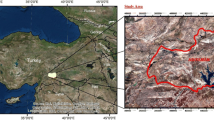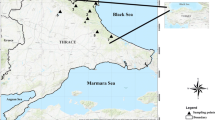Abstract
Key message
Fitting and comparing three sets of additive biomass models for prediction of biomass or carbon stocks of natural and planted Quercus variabilis Blume forests.
Abstract
To make the sum of estimated values from biomass models of various components of a tree equal to estimated tree total biomass for Quercus variabilis Blume (cork oak) forests in North China, single-tree additive biomass models were developed. 100 trees from 100 plots in North China were felled to obtain biomass of aboveground components, and roots of 19 of those trees were extracted for measurement of root biomass. After Box–Cox transformations of variables, two sets of independent component biomass models with a dummy variable to define stand origin were separately built using linear mixed effects analyses (one set of models with site as a random factor; the other set without any random factor). Then three methods were compared to force additivity of those models: sums of linear mixed effects models, sums of linear models, and simultaneous equation fits based on linear models. Model parameters were estimated by ordinary least squares (OLS) or seemingly unrelated regression procedures (SUR). Coefficients of determination (R 2), root mean square error (RMSE), confidence interval of predictions (CI), residuals plots and histograms of residuals indicated that models fitted with sums of linear mixed effects models were the least biased and most precise at estimating total aboveground biomass. Further testing for the linear mixed effects models with jackknife validation and prediction sum of squares (PRESS) statistics indicated that the additive biomass models can be used to predict biomass or carbon stocks of cork oak forests in North China within specific tree diameter at breast height and height ranges.






Similar content being viewed by others
References
António N, Tomé M, Tomé J, Soares P, Fontes L (2007) Effect of tree, stand, and site variables on the allometry of Eucalyptus globulus tree biomass. Can J For Res 37:895–906
Balboa-Murias MÁ, Rodríguez-Soalleiro R, Merino A, Álvarez-González JG (2006) Temporal variations and distribution of carbon stocks in aboveground biomass of radiata pine and maritime pine pure stands under different silvicultural alternatives. Forest Ecol Manag 237:29–38
Bao X, Chen L, Chen Q, Ren J, Hu Y, Li Y (1984) Biomass of Quercus variabilis forest. Acta Phytoecologica et Geobotanica Sinica 84:313–320 (in Chinese)
Baskerville GL (1972) Use of logarithmic regression in the estimation of plant biomass. Can J For Res 2:49–53
Bi H, Long Y, Turner J, Lei Y, Snowdon P, Li Y, Harper R, Zerihun A, Ximenes F (2010) Additive prediction of aboveground biomass for Pinus radiata (D. Don) plantations. Forest Ecol Manag 259:2301–2314
Brandeis TJ, Delaney M, Parresol BR, Royer L (2006) Development of equations for predicting Puerto Rican subtropical dry forest biomass and volume. Forest Ecol Manag 233:133–142
Carvalho JP, Parresol BR (2003) Additivity in tree biomass components of Pyrenean oak (Quercus pyrenaica Willd.). Forest Ecol Manag 179:269–276
Case BS, Hall RJ (2008) Assessing prediction errors of generalized tree biomass and volume equations for the boreal forest region of west-central Canada. Can J For Res 38:878–889
Castedo-Dorado F, Gómez-García E, Diéguez-Aranda U, Barrio-Anta M, Crecente-Campo F (2012) Aboveground stand-level biomass estimation: a comparison of two methods for major forest species in northwest Spain. Ann Forest Sci 69:735–746
Crawley MJ (2012) The R Book, 2nd edn. Wiley, England
de Castilho CV, Magnusson WE, de Araújo RNO, Luizao RC, Luizao FJ, Lima AP, Higuchi N (2006) Variation in aboveground tree live biomass in a central Amazonian Forest: effects of soil and topography. Forest Ecol Manag 234:85–96
Durkaya A, Durkaya B, Ünsal A (2009) Predicting the above-ground biomass of calabrian pine (Pinus brutia Ten.) stands in Turkey. Afr J Biotechnol 8:2483–2488
Fonseca TJF, Parresol BR (2001) A new model for cork weight estimation in Northern Portugal with methodology for construction of confidence intervals. Forest Ecol Manag 152:131–139
Fructuoso da Costa A, Fernando Crepaldi A (2014) The bias in reversing the Box-Cox transformation in time series forecasting: an empirical study based on neural networks. Neurocomputing 136:281–288
Goicoa T, Militino AF, Ugarte MD (2011) Modelling aboveground tree biomass while achieving the additivity property. Environ Ecol Stat 18:367–384
Gómez-García E, Crecente-Campo F, Tobin B, Hawkins M, Nieuwenhuis M, Diéguez-Aranda U (2014) A dynamic volume and biomass growth model system for even-aged downy birch stands in south-western Europe. Forestry 87:165–176
Gurdak DJ, Aragão LEOC, Rozas-Dávila A, Huasco WH, Cabrera KG, Doughty CE, Farfan-Rios W, Silva-Espejo JE, Metcalfe DB, Silman MR, Malhi Y (2014) Assessing above-ground woody debris dynamics along a gradient of elevation in Amazonian cloud forests in Peru: balancing above-ground inputs and respiration outputs. Plant Ecol Divers 7:143–160
Henningsen A, Hamann JD (2007) Systemfit: a package for estimating systems of simultaneous equations in R. J Stat Softw 23:1–40
Jacoby WG (2000) Loess: a nonparametric, graphical tool for depicting relationships between variables. Electoral Stud 19:577–613
Jenkins JC, Chojnacky DC, Heath LS, Birdsey RA (2003) National-scale biomass estimators for United States tree species. Forest Sci 49:12–35
Li H, Zhao P (2013) Improving the accuracy of tree-level aboveground biomass equations with height classification at a large regional scale. Forest Ecol Manag 289:153–163
Luo W, Zhang W, Huang Y (2009) Cork oak. China For Publish House, Beijing (in Chinese)
Madwick HAI, Satoo T (1975) On estimating the aboveground weights of tree stands. Ecology 56:1446–1450
Menéndez-Miguélez M, Canga E, Barrio-Anta M, Majada J, Álvarez-Álvarez P (2013) A three level system for estimating the biomass of Castanea sativa Mill. coppice stands in north-west Spain. Forest Ecol Manag 291:417–426
Muukkonen P (2007) Generalized allometric volume and biomass equations for some tree species in Europe. Eur J Forest Res 126:157–166
Návar J (2009) Allometric equations for tree species and carbon stocks for forests of northwestern Mexico. Forest Ecol Manag 257:427–434
Návar J, Méndez E, Dale V (2002) Estimating stand biomass in the Tamaulipan thornscrub of northeastern Mexico. Ann Forest Sci 59:813–821
Návar J, Méndez E, Nájera A, Graciano J, Dale V, Parresol B (2004) Biomass equations for shrub species of Tamaulipan thornscrub of North-eastern Mexico. J Arid Environ 59:657–674
Parresol BR (1999) Assessing tree and stand biomass: a review with examples and critical comparisons. Forest Sci 45:573–593
Parresol BR (2001) Additivity of nonlinear biomass equations. Can J For Res 31:865–878
Paulo JA, Tomé M (2010) Predicting mature cork biomass with t years of growth from one measurement taken at any other age. Forest Ecol Manag 259:1993–2005
Peng H, Lu Y (2012) Model selection in linear m ixed effect models. J Multivariate Anal 109:109–129
Pinheiro JC, Bates DM (2000) Mixed-effects models in S and S-PLUS. Springer, New York
Ritchie M, Zhang J, Hamilton T (2013) Aboveground tree biomass for Pinus ponderosa in Northeastern California. Forests 4:179–196
Ruiz-Peinado R, Del Rio M, Montero G (2011) New models for estimating the carbon sink capacity of Spanish softwood species. For Syst 20:176–188
Ruiz-Peinado R, Montero G, Del Rio M (2012) Biomass models to estimate carbon stocks for hardwood tree species. For Syst 21:42–52
Saint-André L, M Bou AT, Mabiala A, Mouvondy W, Jourdan C, Roupsard O, Deleporte P, Hamel O, Nouvellon Y (2005) Age-related equations for above- and below-ground biomass of a Eucalyptus hybrid in Congo. Forest Ecol Manag 205:199–214
Sajdak M, Velázquez-Martí B, López-Cortés I, Fernández-Sarría A, Estornell J (2014) Prediction models for estimating pruned biomass obtained from Platanus hispanica Münchh. used for material surveys in urban forests. Renew Energ 66:178–184
Sakia RM (1990) Retransformation bias: a look at the Box-Cox transformation to linear balanced mixed ANOVA models. Metrika 37:345–351
Sakia RM (1992) The Box-Cox transformation technique: a review. Statistician 41:169–178
Sales MH, Souza CM Jr, Kyriakidis PC, Roberts DA, Vidal E (2007) Improving spatial distribution estimation of forest biomass with geostatistics: a case study for Rondônia, Brazil. Ecol Model 205:221–230
Sánchez-González M, Tomé M, Montero G (2005) Modelling height and diameter growth of dominant cork oak trees in Spain. Ann Forest Sci 62:633–643
Sánchez-González M, Cañellas I, Montero G (2008) Generalized height-diameter and crown diameter prediction models for cork oak forests in Spain. For Syst 16:76–88
Schmidt A, Poulain M, Klein D, Krause K, Peña-Rojas K, Schmidt H, Schulte A (2009) Allometric above-belowground biomass equations for Nothofagus pumilio (Poepp. & Endl.) natural regeneration in the Chilean Patagonia. Ann Forest Sci 66: 513
Seifert T, Seifert S (2014) Modelling and simulation of tree biomass. In: Seifert T (ed.) Bioenergy from Wood: Sustainable Production in the Tropics. Springer, Managing Forest Ecosystems 26, 42–65
Shaiek O, Loustau D, Trichet P, Meredieu C, Bachtobji B, Garchi S, Aouni MH (2011) Generalized biomass equations for the main aboveground biomass components of maritime pine across contrasting environments. Ann Forest Sci 68:443–452
Snorrason A, Einarsson SF (2006) Single-tree biomass and stem volume functions for eleven tree species used in Icelandic forestry. Iceland Agricult Sci 19:15–24
Su X, Yan X, Tsai C (2012) Linear regression. Wiley Interdisciplinary Reviews: computational statistics 4: 275–294
Taylor JM (1986) The retransformed mean after a fitted power transformation. J Am Statisti Assoc 81:114–118
Temesgen H, Monleon VJ, Hann DW (2008) Analysis and comparison of nonlinear tree height prediction strategies for Douglas-fir forests. Can J For Res 38:553–565
Tian Q, Zhou R, Zhang J (1997) Biomass research on Quercus variabilis plantations. J Beijing For Univ 19 (SuPP.2): 113–117 (in Chinese)
Torres Vélez DA, Del Valle JI (2007) Growth and yield modelling of Acacia mangium in Colombia. New For 34:293–305
Vallet P, Dhôte J, Moguédec GL, Ravart M, Pignard G (2006) Development of total aboveground volume equations for seven important forest tree species in France. Forest Ecol Manag 229:98–110
Wang X, Fang J, Zhu B (2008) Forest biomass and root–shoot allocation in northeast China. Forest Ecol Manag 255:4007–4020
Wauters JB, Coudert S, Grallien E, Jonard M, Ponette Q (2008) Carbon stock in rubber tree plantations in Western Ghana and Mato Grosso (Brazil). Forest Ecol Manag 255:2347–2361
Zeng WS, Zhang HR, Tang SZ (2011) Using the dummy variable model approach to construct compatible single-tree biomass equations at different scales-a case study for Masson pine (Pinus massoniana) in southern China. Can J For Res 41:1547–1554
Zianis D, Mencuccini M (2004) On simplifying allometric analyses of forest biomass. Forest Ecol Manag 187:311–332
Zianis D, Xanthopoulos G, Kalabokidis K, Kazakis G, Ghosn D, Roussou O (2011) Allometric equations for aboveground biomass estimation by size class for Pinus brutia Ten. trees growing in North and South Aegean Islands Greece. Eur J For Res 130:145–160
Author contribution statement
C Zheng participated in acquisition of data, model building and analysis and writing of the paper. E.G. Mason participated in model building and analysis, writing of the paper and revising of the paper. L. Jia participated in experiment conception, acquisition of data, model analyses and revising of the paper. S. Wei participated in acquisition of data, checking of modelling data and reviewing of the paper. C. Sun participated in acquisition of data, checking of modelling data and reviewing of the paper. J. Duan participated in experiment conception, checking of model and reviewing of the paper. C. Zheng and E.G. Mason have equally contributed to this work.
Acknowledgments
This research was jointly supported by China Scholarship Council, scientific and research base construction projects of Beijing Municipal Education Commission (SYSBL2009), forestry science promotion project of the State Forestry Bureau (2011–44), open fund project of Beijing Forestry University ‘985’ advantage subject innovation platform (000-1108003), and special fund project for forestry public service industry and research (201004021). We acknowledge the strong support from Zhong Tiaoshan National Forest Authority, Xingtai County Forestry Bureau, Si Zuolou forestry station and Xi Shan forestry station in Beijing.
Conflict of interest
The authors declare that they have no conflict of interest.
Author information
Authors and Affiliations
Corresponding author
Additional information
Communicated by R. Grote.
C. Zheng and E.G. Mason have equally contributed to this work and should be regarded as co-first authors.
Rights and permissions
About this article
Cite this article
Zheng, C., Mason, E.G., Jia, L. et al. A single-tree additive biomass model of Quercus variabilis Blume forests in North China. Trees 29, 705–716 (2015). https://doi.org/10.1007/s00468-014-1148-1
Received:
Revised:
Accepted:
Published:
Issue Date:
DOI: https://doi.org/10.1007/s00468-014-1148-1




